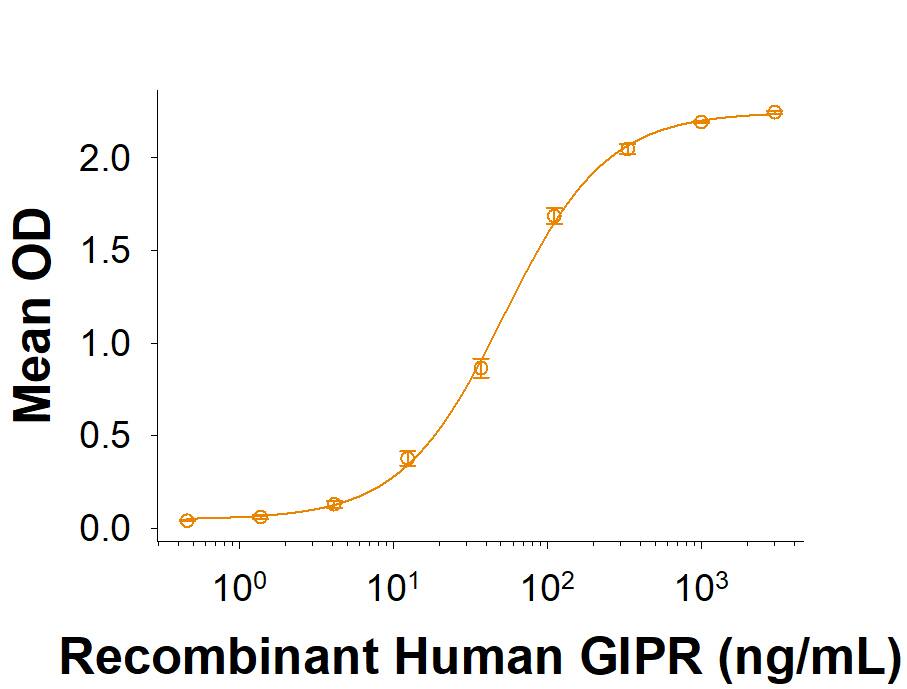Recombinant Human GIPR Fc Chimera Protein, CF
R&D Systems, part of Bio-Techne | Catalog # 11088-GI

Key Product Details
Product Specifications
Source
Human embryonic kidney cell, HEK293-derived human GIPR protein
| Human GIPR (Gly26-Gln138) Accession # P48546.1 |
IEGRMD | Human IgG1 Fc (Pro100-Lys330) |
| N-terminus | C-terminus |
Purity
>95%, by SDS-PAGE visualized with Silver Staining and quantitative densitometry by Coomassie® Blue Staining.
Endotoxin Level
<0.10 EU per 1 μg of the protein by the LAL method.
N-terminal Sequence Analysis
Gly26
Predicted Molecular Mass
40 kDa
SDS-PAGE
45-59 kDa, under reducing conditions.
Activity
Measured by its binding ability in a functional ELISA.
When Biotinylated Human GIP Peptide is captured on a Streptavidin Coated Plate (Catalog # CP004), it binds to Recombinant Human GIPR Fc Chimera. The ED50 for this binding is 20.0-100 ng/mL.
When Biotinylated Human GIP Peptide is captured on a Streptavidin Coated Plate (Catalog # CP004), it binds to Recombinant Human GIPR Fc Chimera. The ED50 for this binding is 20.0-100 ng/mL.
Scientific Data Images for Recombinant Human GIPR Fc Chimera Protein, CF
Recombinant Human GIPR Fc Chimera Protein Binding Activity.
When Biotinylated Human GIP Peptide is captured on a Streptavidin Coated Plate (CP004), it binds to Recombinant Human GIPR Fc Chimera Protein (Catalog # 11088-GI). The ED50 for this binding is 20.0-100 ng/mL.Recombinant Human GIPR Fc Chimera Protein SDS-PAGE.
2 μg/lane of Recombinant Human GIPR Fc Chimera Protein (Catalog # 11088-GI) was resolved with SDS-PAGE under reducing (R) and non-reducing (NR) conditions and visualized by Coomassie® Blue staining, showing bands at 45-59 kDa and 90-120 kDa, respectively.Formulation, Preparation and Storage
11088-GI
| Formulation | Lyophilized from a 0.2 μm filtered solution in PBS with Trehalose. |
| Reconstitution | Reconstitute at 500 μg/mL in PBS. |
| Shipping | The product is shipped at ambient temperature. Upon receipt, store it immediately at the temperature recommended below. |
| Stability & Storage | Use a manual defrost freezer and avoid repeated freeze-thaw cycles.
|
Background: GIPR
References
- YAMADA, Y. et al. (1995). Genomics 29:773.
- Parthier, C. et al. (2007). Proc.Natl. Acad. Sci. U.S.A. 104:13942.
- Sherman, S.K. et at. Surgery. (2013) 154(6): . doi:10.1016/j.surg.2013.04.052.
- Yagub, T. et al. (2010) Molecular Pharmacology. 77(4):547.
- Volz, A. et al. (1995) Febs Letters. 373(1):23.
- Kieffer, T.J. et al. (2003) Trends Pharmacol Sci 24:110.
- Torekov, S.S. et al. (2014) J Clin Endocrinol Metab. 99:E729.
- Shi, X, et al. (2021) Bioconjug Chem. 32:1763.
Long Name
Gastric Inhibitory Polypeptide Receptor
Alternate Names
PGQTL2
Gene Symbol
GIPR
UniProt
Additional GIPR Products
Product Documents for Recombinant Human GIPR Fc Chimera Protein, CF
Product Specific Notices for Recombinant Human GIPR Fc Chimera Protein, CF
For research use only
